On Monday, I posed a question to you as to why, when you photograph the Sun at the same exact time every day for a year, you get something that's shaped like a figure 8, like so:
We got a good number of thoughtful comments, many of which are on the right track, and many of which have some misconceptions. Let's clear them up, and then let's give you the explanation of what gives us our figure 8, and why other planets make other shapes.
What does the analemma look like at other places on Earth? You can see, above, that (from the ruins) the above analemma is from the Northern Hemisphere. Well, in the Southern Hemisphere (G'day to my Aussie readers!), it looks like this:
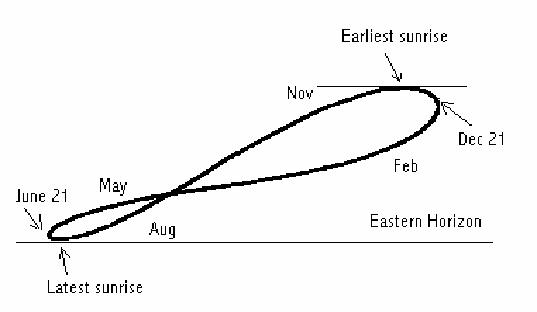
So, at the North Pole, the analemma would be completely upright (an 8 with the small loop at the top), and you'd only be able to see the top half of it. If you headed south, once you drop below the Arctic Circle, you'd be able to see the entire analemma, and it would start to tilt to one side the closer to the horizon you photographed it. By time you got down to the equator, the analemma would be completely horizontal. Then, as you continued to go south, it would continue rotating so that the small loop was beneath the large loop in the sky. Once you crossed the Antarctic Circle, the analemma, now nearly completely inverted, would start to disappear, until only the lower 50% was visible from the South Pole.
So when you do an image search and you find one that looks like this:
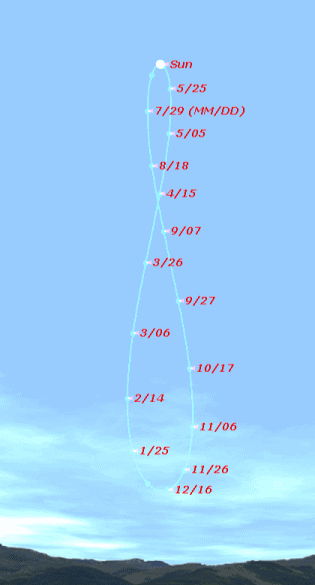
you know that it's photoshopped or faked, because complete, upright analemmas with other stuff on the horizon aren't completely visible from Earth! The only exception? If you photographed the Sun at exactly noon every day and never did daylight savings time. But in that case, you should get a picture of the sky, not of the horizon. (So beware of fakes!)
So, now that you know what it looks like everywhere on Earth, you're probably thinking that this analemma has something to do with the Earth's axial tilt. In fact, many of you guessed that that plays a role. You're right! You see, the Sun always traces out a nice arc through the sky, like this series of pictures taken during winter solstice from the UK:
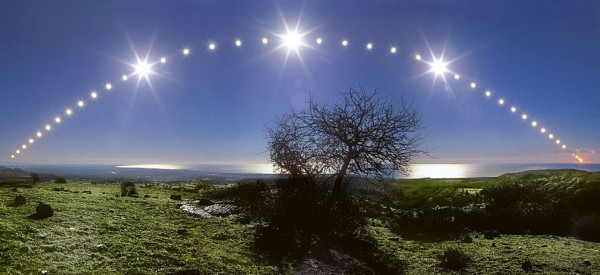
Well, as winter transitions into summer, that arc gets higher and higher in the sky, peaking at its highest point during the summer solstice, and then declining back down to its low point as summer transitions back into the winter. The Earth's axial tilt -- responsible for this phenomenon -- explains why the Sun moves along this direction (drawn in white) of the analemma:

So on a planet like Mercury, where the axial tilt is less than one degree, the Sun's position in the sky doesn't change from day-to-day, and so an analemma on Mercury is just a single point! But something else must be going on; Mars, which has almost the same axial tilt as Earth, has an analemma that looks like this:
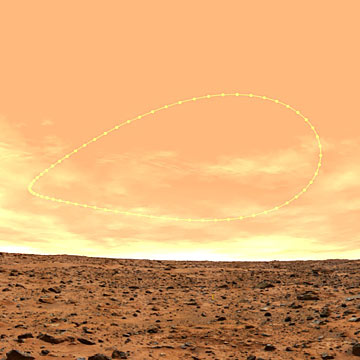
So something must be going on that allows for variations in shape. Some planets see ellipses, some see teardrops, and some see figure 8s. Some see points, too, but they're not as interesting. (There's a list here.)
If the Earth's orbit were a perfect circle, and the Earth always moved at the same speed around the Sun, our analemma would simply be a line**, and the Sun would simply move along that line, reaching one end on the Summer Solstice and the other end on the Winter Solstice. But, no planet's orbit is a perfect circle.
Remember, if you can, Kepler's second law for planetary motion.
A line joining a planet and the sun sweeps out equal areas during equal intervals of time.
In other words, when a planet (with an elliptical orbit) is closest to the Sun (perihelion), it moves fastest. When a planet is farthest from the Sun (aphelion), it moves more slowly.

What this means is that the Earth moves different amounts through the sky as it rotates, which is important. You see, the amount of time it takes the Earth to rotate once is not 24 hours. It actually takes 23 hours, 56 minutes, and 4 seconds. Why are our days 24 hours, then? Because, on average, the Earth revolving around the Sun adds an extra 3 minutes and 56 seconds to each day. But during some days (like in March), it appears that the Sun is moving more slowly, so that 24 hours later -- what we record as a day -- the Sun has shifted its position in the sky.
This difference between the Mean Solar Time, which is our 24 hour day, and the Apparent Solar Time, which is how long it takes for the Sun to return to its same position in the sky, governs this "side-to-side" motion in the analemma. The math is given by the equation of time. But, intuitively, how does this work?
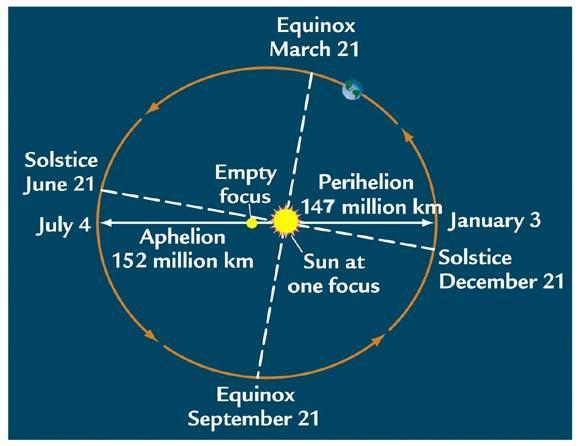
It turns out that aphelion and perihelion are close to the solstices on Earth. During these times, a day is actually very close to 24 hours. When the Earth moves from aphelion toward perihelion (when we're experiencing the autumnal equinox in the Northern hemisphere), the Sun appears to move quickly, and so it reaches its apex in the sky at times slightly earlier than during the solstices. Conversely, when the Earth moves from perihelion to aphelion (during the months of February and March, for example), the Sun appears to move more slowly, and so reaches its apex at slightly later times than normal.
We call these two situations a "fast Sun" and a "slow Sun". If the y-axis of the analemma was due to the Earth's axial tilt, then the x-axis comes from the Sun appearing fast or slow:
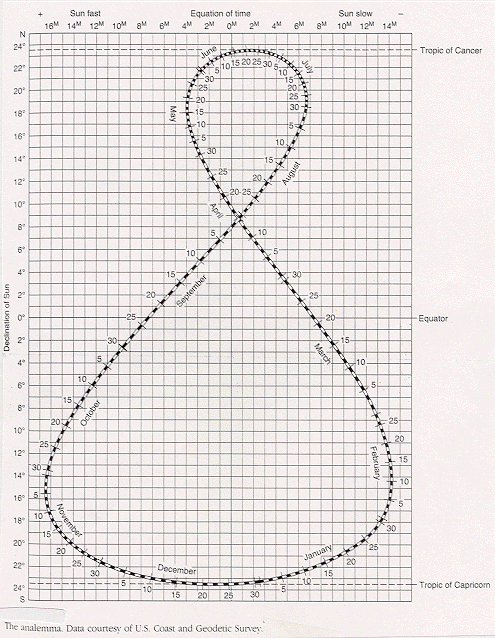
So why is Earth a figure 8 and Mars a teardrop? Because Mars' perihelion and aphelion line up close to Mars' equinoxes, rather than the solstices like it does on Earth. Know what this means? As the Earth's equinoxes precess (which they do over a time period of 26,000 years), the shape of our analemma will change. So enjoy the figure 8 now, while we have it!
Update: An astute commenter has pointed out that the Earth's axial tilt also contributes to the Sun's apparent motion in not just the up-down direction, but also in the "side-to-side" motion. I've managed to find an animated image that shows:
- the effect of eccentricity (what I talked about above),
- the effect of axial tilt (something that most planets have),
- the combined effects of both of these (which gives us our equation of time), and
- the overall path of the analemma, which aligns neatly with the equation of time.
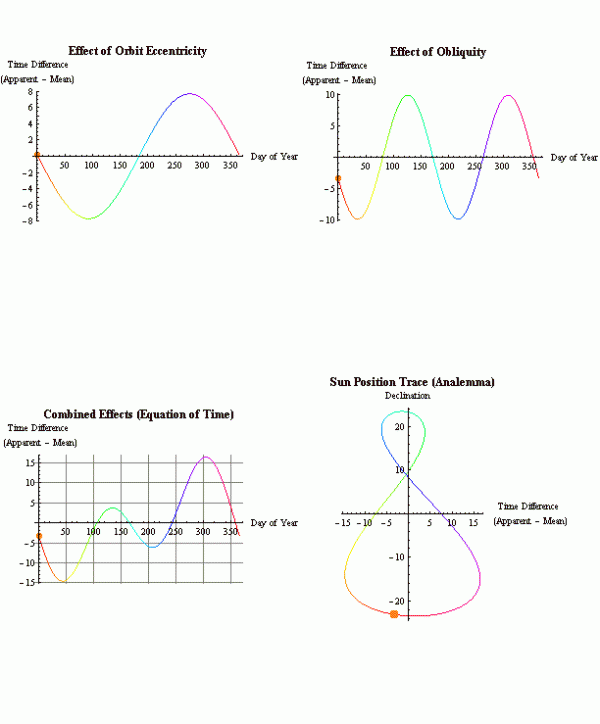
So, if one of these (like eccentricity) always dominates the other (as is the case on Mars), we get a teardrop. If one of them (like eccentricity) is significant and the other is practically zero (as is the case on Jupiter, with a 3 degree tilt only), you get something much closer to an ellipse. And if both are important enough that sometimes eccentricity dominates and sometimes axial tilt dominates (as is the case for Earth, with a tiny eccentricity, and Uranus, with a huge 88 degree axial tilt), you get a figure 8!
** -- Also, note that what I wrote up top about the analemma simply moving up and down in a straight line is also incorrect. The Earth's axial tilt (also called obliquity) would still be present, and would still contribute to the side-to-side motion of the Sun in the sky, even if the orbit were a perfect circle.
So you see, this deceptively simple question is actually incredibly complex, and I make mistakes sometimes!
- Log in to post comments

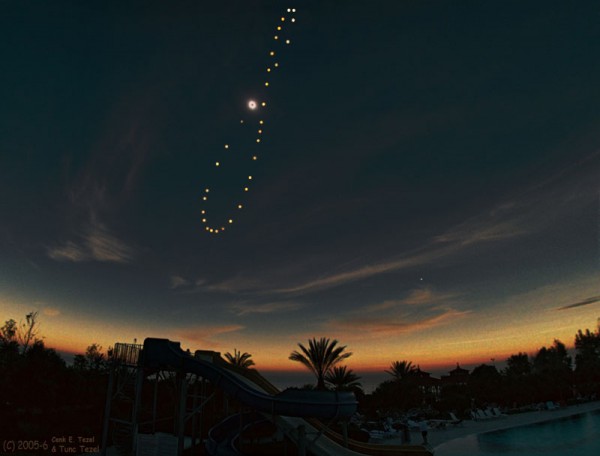
Thanks Ethan, I've wondered about that in the past. Good explanation.
So, does that mean that the bigger loop (Sept - April) is bigger because we're both closer to the sun and moving more quickly around it? Or am I confused?
Thanks! I enjoy your articles!
Um. Isn't the tilt of the analemma due to the time of day, too? At dawn (Northern hemisphere), it leans to the left; at noon, it's approximately vertical (as in the graph); at dusk, it leans to the right. This is just spherical geometry - you can verify it by watching the tilt of rising and setting constellations.
Or just think about standing in the sun at noon: the direction of the sun is close to south at any time of the year, and the angular distance between the low sun of winter and the high sun of summer (about 47 degrees) dwarfs any side-to-side variation.
If the Earth's orbit were a perfect circle, and the Earth always moved at the same speed around the Sun, our analemma would simply be a line, and the Sun would simply move along that line, reaching one end on the Summer Solstice and the other end on the Winter Solstice.
You haven't convinced me of this. I don't have time to duke it out: I'll merely note that the Wikipedia page on the Equation of Time (which, of course, could be wrong) states that there are two components, one due to obliquity, the other to eccentricity. The analemma is merely the plot of the Equation of Time against declination.
Vague of godalming, much like the constellations, the Sun's relative position remains fixed. Although the analemma is different depending what time of day you choose to photograph it, I don't think the leaning that you're talking about is as significant as changing your latitude. Then again, I haven't found any photos of an analemma taken exactly at noon, so I couldn't say I have proof that what I've said is correct!
But your second point is dead on. I have updated my post to reflect this second effect, which is actually quite important for Earth! Thanks for the correction; that will teach me to ask a deceptively hard question!
In the previous thread, I claimed that a circular orbit would produce a straight line analemma between the winter and summer solstice end points. But that was WRONG and I later admitted that everything I said was WRONG after I did some research that disproved my claim.
A circular orbit with a tilted planet gives a figure eight.
Please read this paper, and then review your entire explanation.
Equation of Time - Problem in Astronomy
http://www.ifpan.edu.pl/firststep/aw-works/fsII/mul/mueller.pdf
Please note Figure 12 which plots the equation of time for a variable time interval between the beginning of winter and the passage through the perihelion. This seems to contradict your explanation of Mars having a teardrop analemma, but I am not sure, this is too hard for me.
Not that the paper uses a sun-centered system to take the orbital eccentricity into account, but it uses a geocentered system to calculate the effect of axis tilt. This is why it's mind bogglingly difficult to understand intuitively.
Ethan, thanks. I don't really have a full handle on it all myself, and spherical trig plus Kepler's Second Law sounds too much like hard work.
So complicated!!! Thank goodness for all our brilliant scientists who figure this stuff out for us, and showing us how amazing this universe really is!
For those to whom it makes a difference, and also have an iPhone or iPod Touch, there is a little gem of an App called "Emerald Chronometer" ($5). Amongst other things (UTC, sidereal, true N compass) some of the clock faces show the Equation of Time.
I have no relationship with Emerald other than having bought their App for my Astronomy hobby. But if you like clockworks, like complications, like just plain old passionately meticulous engineering, you'll like this.
Very nice explanationâand a wonderful figure! The great Prof. Isaac Asimov wrote an essay on this exact subject, in the mid-1980s, for the Magazine of Fantasy and Science Fiction (preserved in the compilation Far as the Human Eye Can See), but his was entirely concerned with the analemma as seen from Earth. From Prof. Asimov I learned that if the Earth had a perfectly circular orbit, but retained its axial tilt, the analemma would be a perfectly symmetrical figure 8.
from blog entry:
"So why is Earth a figure 8 and Mars a teardrop? Because Mars' perihelion and aphelion line up close to Mars' equinoxes, rather than the solstices like it does on Earth."
That seems not to be correct.
From NASA: "... approximate alignment of the Martian northern winter (southern summer) solstice with the planet's closest approach to the Sun ..."
http://www.giss.nasa.gov/research/briefs/allison_02/
So the Mars teardrop is due to high eccentricity, as mentioned at the end of the blog post, not because of equinox versus solstice.
Hah! Now I understand what that part of Anathem was about - I bet a given analemma at a high enough resolution can uniquely identify an area on Earth.
It amazes me that people actually figured out all these interactions before the age of computers. Not all that difficult theoretically, it's just geometry + Newton, but I'd never have the patience to actually sit down and to the math ;)
Numerical methods (simulations) are a godsend.
PS: This effect is probably pretty important to understand if you are doing celestial navigation. So I shouldn't be all that surprised... There was lots of money (and military interests) behind that getting that right.
Nice to see my intuition was right. Of course if I'd been wrong it would just have been an unlucky guess :-)
This is a great explanation for the phenomenon. Anyone who saw "Castaway" with Tom Hanks would now recognize the error in the analemma drawn on the cave wall as being too vertical. Hank's character was stranded on a tropic island, and the analemma should have been nearly horizontal.
The winter solstice pictures from the UK look like Vejur's weapons LOLOL (Go Vejur!!!)
Why is the figure eight not perfect????
I must disagree with your comments regarding the 'vertical' analemma, saying that it is photo-shopped or faked. From the fact that all analemmas span 47 degrees of arc, we can estimate that the winter-solstice sun is about 10 degrees above the low hills at the bottom of the photo. Suppose for the sake of argument the hills have an elevation of 3 deg. above a theoretical flat horizon. Thus the winter solstice sun has an elevation (at mid-day) of 10 + 3 = 13 degrees above the southern horizon - just as it does from anywhere on earth at latitude 53 1/2 degress North. The fact that the photo shows more than just sky merely shows that a wide-angle lens was used for the photo.
Great discussion and agree entirely that these are deceptively hard questions! Ethan and vagueofgodalming - my understanding (though I may be wrong) is that the analemma tilts according to the time of day and that the effect can in fact be quite significant depending on where you are. It is the rate at which it tilts (i.e. the rate at which the axis of the analemma appears to rotate through the day) which is dependent on latitude. The rotation is more pronounced the closer you get to the equator and non-existent at the poles. This is because the axis of the analemma is (almost) aligned along a line of constant right ascension (in the equatorial coordinate system) or "meridian of time".
This link (figure 6 is particularly useful for picturing this) provides excellent coverage of the subject (apologies in advance if anyone is offended by the URL - I have no association with this site!). As an example, for any observer, the 6pm meridian of time will be oriented across the horizon at an angle equal to the observer's latitude. The axis of the analemma is almost along a meridian because of the slight difference in the dates of aphelion/perihelion and the solstices. The winter solstice position on the noon analemma is slightly to the west of the summer solstice position - see the graphic on the "analemma" wikipedia entry - so there's a slight tilt (top to east, bottom to west in the northern hemisphere) to the noon analemma.
As the analemma tilts clockwise through the day a vertical analemma is acheived shortly after noon in the northern hemisphere. See here for a sequence of analemmas taken at different times of day. I think part of the confusion about the tilt of the analemma comes from the oft quoted but apparently incorrect assertion that the equation of time is the east-west component of the analemma. It isn't, the equation of time provides the component perpendicular to the chosen meridian of time which is not the same as (horizontal) east-west unless you are either at one of the poles or have chosen the noon meridian.
Sir,
Please infrm why the of Perihelion and Aphelion changes year to yrar, when the length of urbit being 365.25 days approximately.
yours sincerly
A.R.Amaithi Anantham
How would it differ if viewed from the equator? Just moved to Singapore from Michigan in the USA and was rather familiar with this in the northern hemisphere but wonder ho it differs being so close the the middle and a one season place.
My favorite computer application related to the analemma:
http://www.analemma.com/SunGraph/index.html
I found this application years ago and I still use it!
I am just writing to let you be aware of of the incredible experience our daughter had reading your site. She discovered a lot of details, most notably what it is like to have a marvelous coaching style to make many others really easily comprehend chosen complicated topics. You really exceeded our desires. Thanks for giving the valuable, trusted, explanatory and also fun guidance on the topic to Julie.
Dear sir
thank for good explaination.
MY question is According to kepler law earth move fast during perihelion(3 jan anwards) but according to analemma it remain slow ie its running late of 5 to 15 in the january and febrauary month.
What could be the possible answer for this.
thanking you
Venkatesh TC Murthy
Ethan,
This explanation is fascinating and complete. I have one query, below, which if you had a sec to explain would be much appreciated.
Relative to the Sun, the earth is presumably moving fastest at the perihelion (given it is closest to the Sun) in its orbit, slowest at the aphelion.
It would seem to follow then that the Sun should be running latest at the perihelion, since the Earth has travelled further in 24 hours than at any other point in its cycle, hence the Sun's position should lag the Earth's rotation. This is clearly not the case - do you know why?
I'm hoping the answer is nothing to do with gyroscopic precession, which is another concept I struggle to understand.
Thanks,
James
Hi Ethan,
I am building a sundial for 31.9deg. south. Which way does the equation of time work for the southern hemisphere work? +16.5 on 1stNov. or -16.5 minutes.
Regards,
Des.
i am still super confused. i dont think the article really explains it. it only describes the phenomena. i need an explaination so that i can understand why does it happen and predict analemmas on other planets. Sooo...
Roshaan, Gozney, Murthey, and others:
The analemma tells where the Sun really is, relative to where it would be if it moved its average amount each day (0.9856 deg = 360 degree / 365 day)
yes, at perihelion Earth orbits thru a much larger angle each day (fastest speed and also closest) - that is why it is _changing_most_rapidly_ then. Like seasonal temperatures, lack of sun around the solstice lets Earth become cooler then - it's not yet as cold as it will become.
Earth orbits 0.986 degrees each day plus or minus 3 percent (our eccentricity). The biggest effect is the 23½ degree tilt of the Sun's path among the stars (tilted Northward at March Equinox). So at the equinox, the Sun's Westward component is only 92% (= cos 23½) of its full motion. At the solstices, the meridian lines (which measure "Westward" motion) are more closely-spaced by the same factor. so the tilt has plus or minus 8%.
To answer ALL of EVERONE'S questions: at your local library, see "Celestial Navigation" by Roy T. Maloney. The analemma, and more importantly, how to use it in navigation for DED RECKONING, is clearly explained. Although, as a sailor, I had to study some of it several times to get it through my thick skull.
I keep one (a copy of the analemma) on my sailboat at all
times. If you understand the analemma (and have a watch)
you can know (within a degree or two, i.e., approximately 60
to 120 nautical miles at the equator, where you are. Since
you'll probably never be at the equator, you'll also learn how
to figure the distance(length) of a degree at your approxi-
mate latitude. Maloney's book is VERY interesting, particularly if you're a
sailor. On page 77 of his book (its only 120 pages, so not a
lengthy tome that'll take you weeks to get through) he refers
to 'ADRIFT" by Steven Callahan, a must read for almost any
one: a true and remarkable saga.
In the animation, is the Sun traversing the analemma in the wrong direction?
Did anybody answer why the figure eight is lopsided so that the bottom half is noticeably bigger than the top half??
Josh it doesn't make sense to me either. 8 should be close to perfect..if distance at perihelion is 147 mil km and aphelion 152 mil km, above image is misleading (that illustrates Earth movement in 1 month at aphelion and perihelion). Sun should be almost at centre (like in the next image of the page), given the distances..and assuming Earth moving THAT much faster in perihelion to create small loop is not really believable..
Zaid Smith #30 ---- You are correct.
Kepler’s 1st law of planetary motion says that the earth’s area speed is constant throughout the year, but it’s linear and angular speed are not. So when the earth is moving from Aphelion (furthest sun) towards Perihelion (nearest sun), the sun appears to slow down (from earth’s perspective) as the earth traverses its longest arc in the elliptic. And from Perihelion to Aphelion along the shortest arc, the sun appears from our perspective to speed up. This is because, when the earth is closest to the Sun (perihelion), it moves fastest. When the earth is farthest from the Sun (aphelion), it moves more slowly. (Exactly opposite of what we observe). By appearance (in reality) --The sun appears to speed up as we move from summer to autumn and the sun appears to slow down as we move from winter to spring. (Exactly opposite of what Kepler's law predicts). If you look at the Analemma on a globe, where it is correctly shown, with the small loop (fast sun) at the top, and the larger loop (slow sun) at the bottom, you would put the Aphelion at the TOP and the Perihelion at the Bottom. Now you can see that Kepler's model does NOT comply with observations. Which proves that Kepler's model does NOT describe the sun's movement, AS IT IS.
Tauno 32. The analemma is a consequence of TWO phenomena, not just one. (People seem to concentrate more on the variance of the earths velocity, and forget about the obvious effects of obliquity). The combination of those two phenom is what gives the analemma its odd shape. Also, consider the fact that the effects are cumulative. And the fact that the earth speeding in its orbit causes the sun to appear to drop behind. Notice that the analemma graph dramatically demos this fact -- between Nov 5, and Feb 12, the sun drops about 31 minutes, or almost 8 degrees behind where it was on Nov 5th. (Your sundial went from 16.5 minutes fast to 14.5 minutes slow)
The remark that an upright analemma is "photoshopped or faked, because complete, upright analemmas with other stuff on the horizon aren’t completely visible from Earth!" is confusing to me. I'm currently in the process of shooting one:
www.flickr.com/photos/markusderrer/27642575510
This is at 12:30 PM (Standard) / 1:30 PM (DST) from 49 degrees north in Brandon, Canada. I'm using a wide angle lens and clearly have a horizon and an upright analemma.
To be fair I am using photoshop but only to layer the images. The alternative would be to shoot on film with a camera that doesn't advance which would be difficult.
Also what did you mean by "never did daylight savings time". I think that could confuse some people into thinking they don't need to account for it.
is there a time of the day or month when the son have the strongest effect on the earth
What will the analemma look like 5,000 years from now, when perihelion occurs near the March equinox?
In trying to lay out all this to my granddaughter, the issue of obliquity was difficult for me to put into words what seems to make intuitive sense to me. I am not an astronomer or a navigator but an architect. So, I understand that when the direct rays of the sun are on the equator at an equinox, the figure traced by extending the line of the rays is a plane and is hours are marked a radii, the sum of the interior angles is 360 degrees, However, at the solstices (actually any other time of the year except the equinoxes) the figure traced is a cone. And the sum of the angles at the base of the cone is always less than 360 degrees. In fact, if the rays shown directly on a pole, the total of the angles would be 0 and the figure would be a straight one coincident with the axis of the earths rotation. The distance that is traveled by the direct rays at the equinox is longer than the distance traveled at any other time. But, the time between solar noons is always 24 hours plus the time for some additional rotation as the earth travels forward in it orbit and its orientation to the sun changes.
This all tells me that this should affect the length of a "day" and the changing effect over time will be a double sine curve.
But just how to say why this is so escapes me.
Help?
William Clark
One thing that always gets mixed up in these discussions is the graph of the analemma and the analemma itself at it would appear in the sky if photographed at a regular (averaged) interval (like 24 hours). As we see in the photos, the actual shape is much narrower than it is when graphed to make it easier to read the time differences.
The statement that the analemma on Mercury would be a single point is not correct and clashes with the later statement that the analemma on Jupiter (also with very little tilt) would be an ellipse. Both still have eccentric orbits and so the sun would be fast or slow at the closer or further points of the orbit. What would not change is the declination of the sun, but unless the tilt is zero which it almost never is, most graphs will take the tiny tilt and exaggerate it so you'd still get a large analemma figure 8 or tear drop 'shape' of some kind.
The fact is you would see the analemma as a line in both cases (but not the erroneous vertical line of declination change which the author corrected) but a line with the fast or slow sun at either end. Technically with even a small tilt this line could be defined as a very narrow ellipse but it wouldn't be very noticeable as such. This would be the case for the planets with a small tilt.
For planets with more tilt you get the figure 8 or tear drop. It was mentioned that if the eccentricity of the orbit is greater and overshadows the effect of the tilt you'll get the tear-drop which is really just the figure 8 with one very small loop. This was somewhat confused with the effect of where the eccentricity of an orbit lines up with solstices and equinoxes which really just determines whether the analemma leans to one side or another or which loop/side of the figure 8 (or point on the tear drop) is smaller.
As the the Earth precesses the shape of the figure 8 will shift and lean but it will remain a figure 8 as long as the eccentricity of the orbit doesn't increase by a significant amount.
All things considered though, this is the most thorough discussion of the concept I've seen in a long time.
I'd love to see an app that let you play with the values of tilt and eccentricity to see the effects and NOT just on a graph (I've found some of those) but for the actual change in degrees of angle you'd observe in the sky as a result of the tilt and the faster or slower apparent sun.
I would be interested in any follow-up on comment #38.